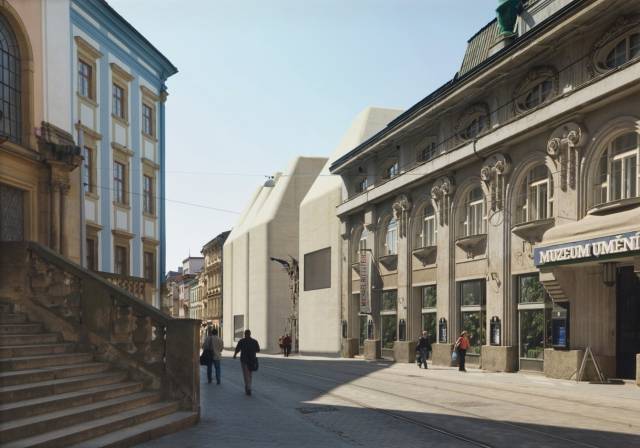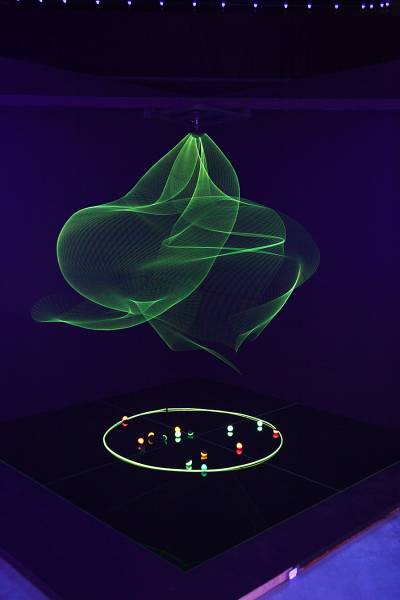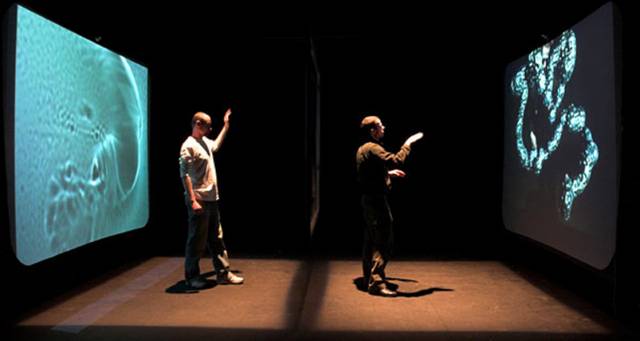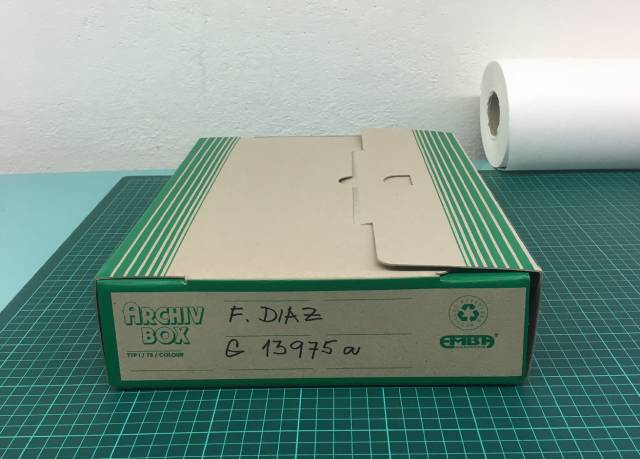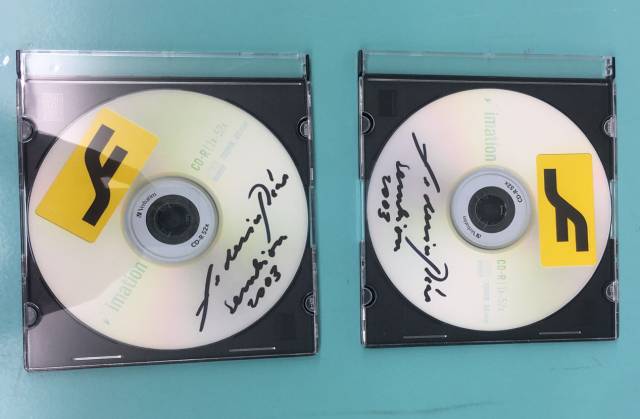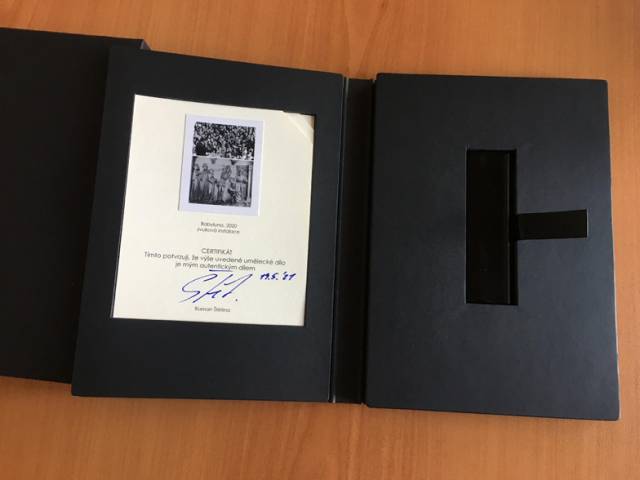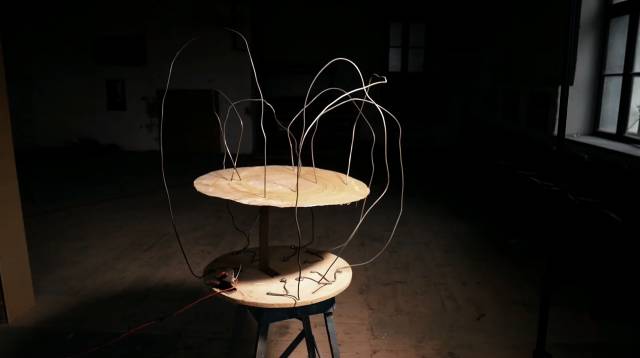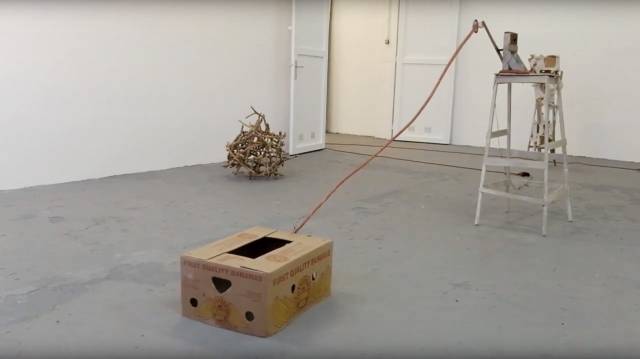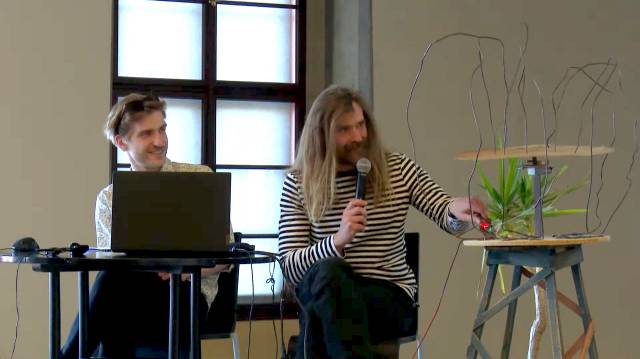New Media Museums Proceedings, 2022
Special Requirements – Four Cases from the Collections of the Olomouc Museum of Art
Table of Contents
Introduction
This text is an attempt to summarise what preceded the establishment of the New Media and Intermedia Collection at the Olomouc Museum of Art (OMA) and to share experiences with the handling new media artworks in state museum institutions. Using the example of two works of art that were acquired prior to the establishment of the collection and two works that were acquired for it, this article seeks to outline the specific issues that arise in the pre-acquisition process, the documentation and registration of these works and their components, the restoration/conservation processes as well as the storage and back-up of the works, and finally their appropriate presentation at exhibitions. The article is based on my practical experience, was written with the help of and in consultation with colleagues from various departments – restorers, documenters, curators, IT workers – and therefore also includes personal testimonies of people who were part of the acquisition process.
The establishment of a collection must be based on the long-term strategies of the institution, its internal organisation and ambitions, as well as the professional interest and preferences of the curators. On the other hand, it must be adjusted to the real possibilities of the institution, its acquisition potential and availability of artworks, its technological background (restoration workshop, technical staff, storage and depository conditions), professional support (curators, inter-institutional communication) and the ability to provide care for the artworks and keep them operational. In the case of new media and intermedia, this often depends on the ability to anticipate the turbulent development and rapid obsolescence of the technologies that these works use. And while the digital footprint of contemporary art grows hand in hand with technological developments, the works of new media pioneers become obsolete and are doomed to extinction if not treated according to their specific needs. This results in the critical loss of a substantial part of the evidence of progressive artistic thinking of the second half of the 20th century and of contemporary artworks. Ensuring quality facilities and extensive research in this area is therefore an obligation for a 21st century memory institution dedicated to collecting modern and contemporary art.
In recent years, the Olomouc Museum of Art has significantly expanded its presentation and collection of new media and intermedia art. Media works have become a regular part of thematic exhibitions, interventions in short-term exhibitions are common, and acquisitions are also taking place. OMA has initiated the research project New Media Museums, which builds on its prior research on digital platforms and databases and brought together experts from different institutions in the V4 countries. All of the above led the museum to consider establishing a new collection. Although it may seem that the establishment of a collection without relevant artworks to be included in it is a reverse process, we see it as an opportunity to develop methods and establish satisfactory conditions for the acquisition, registration, preservation and display of artworks.
Towards the New
The Olomouc Museum of Art consists of three parts – the Museum of Modern Art + the Central European Art Forum and two archdiocesan museums – the Archdiocesan Museum Olomouc and Archdiocesan Museum Kroměříž. The Museum of Modern Art with the Central European Art Forum focus on 20th century art with an extension to the late 19th century and contemporary art. The Archdiocesan Museums, on the other hand, care for the Archbishop’s collections and other heritage from the Romanesque period to the 19th century and they include art objects, but also archival materials, books, maps and other artifacts.
The focus of OMA is thus split between modern and old art. Until recent years, however, the museum did not acquire the most recent works of art nor did it concentrate on the younger generation of artists. This was justified by the long-term values the museum stands for and the interest of curators mainly in the progressive art forms of the unofficial scene of the 1960s, 1970s, 1980s and the transition period, but not so much in the progressive tendencies of artists who began working after 2000.
When the project of the Central European Art Forum (SEFO) was founded in 2008, its idea was to transform the museum of modern art into a museum of contemporary art with a focus on 20th century art ending in 1989 (with a main interest in the totalitarian period). As the project evolved in relation to the current needs and possibilities of museum institutions, its lack of focus on recent periods became a limitation for a contemporary institution. This resulted in a modification of the concept and, subsequently, the acquisition of artworks from the 1990s as well as post-2000 works.
Fig. 1: Jan Šépka, SEFO – Central European Art Forum. Architecture visualisation. ©OMA
However, although the museum's collections grew, other gaps in the collections became increasingly apparent as curators' interest in traditional media (especially painting and sculpture) outweighed the already rapidly expanding art production in new media and intermedia. It should be noted that this situation was and still is common in most museum institutions in the Czech Republic and is similar in the Central European region as well.1)
Reflecting the Old
This was the main reason to start the New Media Museums project dedicated to the reflection of art collections, with the aim to use and share the experience gained in different types of organisations to promote qualified acquisitions and professional care of artefacts of impermanent nature. Prior to the launch of the project, an internal survey of OMA's collections was undertaken to identify the most significant works of art with reference to new media and intermediality. Although at that time there was only one work in the collections that could be described as a 'new media' artwork,2) there were several artworks that required similarly complex treatment, whether in terms of acquisition, classification and registration, preservation or display. The first issue to be addressed in this project was the reasoning behind restraint in the acquisition of media artworks. In my conversations with curators who worked at the OMA after 2000, three main arguments recurred.
- Lack of expertise
This is not to say that the curators were not familiar with new media art, but rather that they were aware of the technical infrastructure and specific requirements that collecting new media art entails, and were well aware that these requirements could not be met under current conditions.
- Specialised institutions
Around the year 2000, there were already other institutions specialized in collecting and preserving new media - the Research Centre of the Academy of Fine Arts, the National Gallery in Prague, etc. Since the OMA collections are media-oriented, new media were perceived separately also from the point of view of collecting. The prevailing opinion was that contemporary art could be collected according to the traditional division of media, and new media were thus neglected.
- Act No.122/2000 Coll.
The act on the protection of museum collections requires the custodian of the collection to “ensure the protection of the collection from damage” and “to preserve the collection in its entirety as it is recorded in the central register.” According to the museum collection manager, the law does not sufficiently define the treatment of intangible objects. Since it is the museum that guarantees the proper presentation of its artworks and, above all, their preservation for future generations, considerable responsibility lies with curators, depository staff, conservators and other museum staff. These considerations ultimately outweighed the curators' desire to expand their collections of modern and contemporary art to include works of new media.
Although the law has not changed and the technical infrastructure is still far from ideal for handling media artworks, the thinking in the institution has gradually evolved in recent years. The preferences and experiences of a younger generation of curators who have followed the accelerating transformation of the art scene have played a fundamental role in this process. Over time, it became clear that new media works did not belong only to specialised institutions, but became a natural part of contemporary art. And while much of preservation work can be done by specialised institutions, representative collections of contemporary art themselves cannot do without new media works. The way forward has been then to collaborate on functional methodologies that can form the basis for future modifications. At the same time, these ambitions are subject to the consideration of the management on the institution’s capabilities, objectives and long-term strategies.
With the idea of establishing a New Media collection, there was a need to review the OMA's collections to find works relevant in the context of new media and intermedia. The largest group of works were kinetic sculptures and interactive objects, which are part of the Collection of Sculpture. The selection of artworks does not necessarily represent the precursors of new media, nor does it necessarily include only artists who later focused on new media. Rather, the works were selected based on treatment requirements, either in exhibitions or in depositories. These are mainly kinetic, optical and light sculptures by artists such as Stanislav Zippe, Milan Dobeš, Juraj Bartusz, Václav Cigler, Hugo Demartini, Radoslav Kratina and others. Some of the works are not kinetic or interactive in the true sense of the word, rather they were created as mobile objects or variables, but could not be used in the gallery conditions and were exhibited as static objects.
Among the selected works are three kinetic light sculptures by Slovak artist Milan Dobeš - Kinetic Relief, Pulsing Rhythm, Attraction of Red Buildings - all created in the 1960s and belonging to the early period of constructivist experimentation with movement. Another example is the light sculpture Light Point - Cut Glass by Václav Cigler, which uses a spotlight placed behind a large glass plate. A characteristic element of these sculptures is their variability, which strongly influences the final appearance and effect, as well as the conservation treatment of their parts and their storage.
One work stands out in the Collection of Sculpture, Sembion by the Czech-Argentine artist Federico Díaz. Sembion is the only work that can be viewed as new media art and embodies most of the issues and problems associated with collecting and preserving new media. These issues are elaborated below.
In addition to those mentioned above, there is also a sub-collection of action art that belongs to the Collection of Photography. Although these works hardly fit into the field of new media art, certain affinities can be found in the nature and problems of their classification and in the importance of documentation.3) These issues, however, are beyond the scope of this article.
Cases
Stanislav Zippe – Spiral
A special place in the Collection of Sculpture is dedicated to Stanislav Zippe. He belongs to the generation of pioneers of new media and his work Spiral is of unquestionable importance as one of the first installation artworks in Czechoslovakia. Spiral builds on Zippe's series of luminescent variations - environments usually made up of lights, mirrors and various objects. Spiral is installed in a black box or in a room lit by UV lights and black mirrors on the floor. On the mirrors are placed several spheres painted with fluorescent colours and a fluorescent circle. Above them, mounted to the ceiling, an engine rotates a suspended fluorescent wire to create impressive kinetic and light effects.
Zippe created the work as early as 1969 and included it at his solo exhibition at the Gallery on Charles Square, but it was not shown again until 1993, when it appeared at the Poetry of Rationality exhibition curated by Jiří Hlaváček at the Wallenstein Riding School.4)
OMA acquired the installation from the artist in 2000, when it was on loan to the National Gallery in Prague. During an exhibition there, the engine turning the spiral collapsed and damaged not only the glass parts at the bottom, but also the engine itself.
Fig. 2: Stanislav Zippe, Spiral, From Titian to Warhol, 2012. OMA Collection. ©OMA
During restoration work, the OMA curators and conservators were in contact with the artist, but he had no specific requests or instructions for repair or reconstruction of the work. In the end, the work was restored with the help of local technicians using components of an old photocopier.
In 2012, Spiral was exhibited at the From Titian to Warhol exhibition at the OMA. The artist was consulted about reconstruction and suggested suitable dimensions for the installation, but did not specify them in detail. Neither the number nor the design of the objects belonging to the installation was specified by the artist, and the photographic documentation from previous exhibitions was of little help. Several photographs from the 1969 exhibition focus primarily on capturing the movement of the spiral instead of the technical setup of the work as a whole.5) The photo documentation of the 1993 exhibition Poetry of Rationality has not survived due to the transformation and relocation of the museum.6)
The reconstructed version of Spiral was well photographed and a short video was made during the 2012 exhibit. This visual material can be used as a reference for future exhibitions of the work. Depository storage appears to be unproblematic, as does the inventory of parts of the installation, which means that the current condition of the work is stable and Spiral can be exhibited and loaned. However, some important data is still missing. For example, the restoration report lacks information on the replacement of the engine. A revision is therefore necessary to document the current state in detail and to record as much as possible about the former conditions of the piece.
The OMA is aware of its normative role in the process of setting standards for the display of work and that the installation methods used in From Titian to Warhol are determinative of future exhibitions. Any further documentation of previous arrangements of the work, as well as accompanying documentation (sketches, written notes…) by the artist or a record of his memories, can play an important role in terms of art historical research.
Federico Díaz – Sembion
Fig. 3: Federico Díaz, Sembion. Installation view. ©Federico Díaz
Probably the most complex example of all the media artworks in the OMA collections is the work Sembion by the Czech-Argentine artist Federico Díaz. Sembion has all the hallmarks of an intermedia artwork, combining an interactive software and audiovisual installation along with automatically designed objects and digital prints.
The technical details provided by the artist:
PC, C++ software, semantic analyser, optical sensor, data projector, semi-transparent material, polyamide material, acoustic insulation, SLS rapid prototyping objects, data network size projection room of flexible dimensions.7)
The artist’s statement on the work:
The aim of the project is to convert speech into visual forms through specially programmed software. Voice recognition detects the speech of visitors to the installation and analyses not the meaning, but the syntax and conventionalised phrases and converts them into a pre-built dictionary of shapes. The result is a set of data visualised as metablob systems through stereolithography technology and rapid prototyping. The project was developed in collaboration with the Research Centre of the Academy of Fine Arts in Prague and the renowned art theorist Jiří Ševčík.
The project was also presented at the exhibition Die Algorithmische Revolution at the ZKM in Karlsruhe and the ICA in London.8)
Sembion was originally designed as a software for data visualisation using written text as source material. The text, originally a single book, the anthology Czech Art 1938-1989, was analysed according to its morphological and semantic structure and the data obtained was subsequently transformed into 3D visual form of so-called metablobs projected on the screen. When exhibited as an interactive installation, sensors connected to the program also responded to motion, touch, voice and colour stimuli from visitors, further varying the resulting image. Subsequent displays of the piece used various texts published on the internet as source material, expanding the software's dictionary. However, the idea of translating the texts according to their content and meaning was never implemented due to technical difficulties. Neither the reflection of visitors' emotions or their physical condition in the resulting visualisation was possible during the years of software development.
The visual outputs of the analysed texts, the “metablobs” - constantly changing fluid forms resembling mercurial substances - constitute an important part of Díaz's work. Their shape responds to each new input - each word in the text, every visitor in the room - and constantly adapts its form. Díaz used these digitally produced metablobs (created without the direct involvement of the artist) to create physical objects using a method called Selective Laser Sintering (SLS), a precursor to 3D printing. The method involves sintering a thermoplastic powder medium with a laser beam to create abstract sculptures. Díaz continued this method in the following projects. These small sculptures were then exhibited alongside the Sembion installation, either alone or as part of other installations.
Sembion was offered to OMA in 2007 by the private gallery Zdeněk Sklenář as a set of works. It consisted of software on CD-R with one extra copy (both copies signed by the artist), three large format digital prints showing a metablob adjusted and signed by the artist, and a sculpture produced by SLS. The set also included a complementary element to the SLS sculpture - a luxurious looking platform made of shiny red plastic, belonging to the Fluid F1 project, suggesting a merger of two independent projects.9).
Fig. 4: Federico Díaz, Sembion. Depository storage. ©OMA
Both CD-Rs contain a single file - the boot command – that should launch the Sembion software. However, the software itself is stored elsewhere. It is not clear what else (software or hardware) is needed to reconstruct the installation as it was presented in 2003-2005, nor what the exact function of the software is. This question - arguably the most problematic about Sembion as a collection object - belongs not only to the category of collecting and documenting new media, but also to licensing and authenticity, and in a broader sense to the ontology of digital art. This, however, appears to be a problem that is eminently museum-related, which may be one of the reasons why Díaz decided to turn to privately funded and commercial projects.
Fig. 5: Federico Díaz, Sembion. Depository storage. ©OMA
Since the acquisition, Sembion has been exhibited only once at the From Titian to Warhol exhibition at the OMA, where only the SLS object was on view with video documentation of the installation without interactive elements.
In short, a museum that had never acquired such artworks before and had not necessary care in place, acquired an art piece that simply proved to be non-functional before it could be displayed. And since the original software soon became obsolete and similar interactive software is being developed in many fields, this work is simply a testament to the progressive ambitions of early software art in this country.
From the OMA's perspective, three options for future display seem relevant: 1) Reconstruction of the work using the original software with an adequate hardware constellation; 2) Acquisition of archival materials and documentation of the installation as it was exhibited at the ICA London or ZKM Karlsruhe, thus showing it as a document of once progressive technologies; 3) Function-based emulation - using the current system to imitate the work's functioning. The last option seems to be the most problematic and opens up questions of authenticity and integrity of the work. Documentation of the original modification would be an essential part of such an installation. The artist's statement may play a decisive role in this case, but all efforts to contact Federico Díaz have so far been unsuccessful.
Roman Štětina – Babyluna
The gradual change in the aims and ambitions of OMA and SEFO has led to a greater representation of contemporary progressive art forms and the introduction of artists of the younger generation in exhibitions and collections. These include contemporary interventions in exhibitions of canonical works of art, transhistorical approaches within the permanent exhibition, site-specific and public-art realisations within the SEFO Triennial, and many more. All of these reflected the tendency towards intermediality or post-media approaches and presented new technological challenges for curators, installers and conservators.
Among them was an artistic intervention created by Roman Štětina - Czech intermedia artist, laureate of the Jindřich Chalupecký Award and assistant of the studio of intermedia art at the Academy of Fine Arts in Prague.
Fig. 6: Roman Štětina, Babyluna. Depository storage. ©OMA
The work was commissioned for an exhibition by Jiří Kolář, which is part of the confrontage series Babyluna. Kolář's album, consisting of 52 individual sheets with two confronting motifs on the front and the artist's epigrams on the back of each sheet, became Štětina's inspiration in terms of semantics and form. The resulting intervention consisted of a sound installation in which a male voice (radio director Miroslav Buriánek) reads the epigrams and tries to find the correct pronunciation and intonation for each of them, while in the background we hear Štětina clicking his mouse while cutting and editing the resulting work. The articulation of the collaging process triumphed over the content of the spoken word. Another part of Štětina's intervention was his variation or appropriation of one of Kolář's confrontages - when he uses Google image search to vary one of the sheets and the result is a new confrontage, not dissimilar to the original one, but created purely by Google's algorithms.
The installation is intended to be invisible, playing from conventional stereo speakers mounted to the ceiling of the room, presenting only the voice and clicks. The piece thus consists only of a data file and a set of instructions that were communicated in advance via email between the curator, the artist and a member of the audiovisual team.10) After much debate, the decision was made to omit any visible - or even visually appealing - sound reproduction devices, leaving the final 'form' of the work to the curator and the technological possibilities of the space.
Roman Štětina's Babyluna was then proposed for acquisition as the first new work for the newly established New Media and Intermedia Collection and was eventually acquired also as the first sound work in the OMA's collections. Communication with the artist then began to establish the terms of the purchase and its actual subject matter. At this point, the artist's experience in selling videos in particular was of great help to the curators and documentarians. Babyluna was delivered as a data file on an SSD stored in a simple black case with a certificate of authenticity and a technical sheet. The certificate confirms that the work was produced in a 1/1 edition by the artist himself, while the technical sheets describe what the SSD contains and how the work should be handled and displayed. The work’s file therefore includes:
- Basic specifications
- Archival and exhibition copies
- Technical requirements
- Display manual
- Labelling information
The basic specification describes what files are stored on the disk (in this case, one archive copy file and one exhibition copy file) and what their technical specifications are - file type, length, channels, bitrate, and sample rate. The second section contains a simple description of the physical contents of the case. The technical requirements describe the appropriate display of the work (stereo sound system/headphones, playback options, type of device) and specify the file conversion and compression options. The display manual states that when displaying the work in a room with other works, it is recommended to use acoustic and sound absorbing materials. Finally, the fifth section provides information that should be included on the label.
In addition to the case with the disc, the acquired work includes a box frame with the original print labelled and signed by the artist.
In terms of sustainability, Babyluna appears to be relatively trouble-free, with OMA having documentation designated by the artist. The work, which was the first to be included in the New Media and Intermedia Collection, served as a case study in terms of registration and inclusion in the database, as well as in terms of file storage and backup within the museum's data storage system. The entire technical documentation system was designed by the artist himself, which demonstrated Štětina's experience in the production and sale of video and sound works.
Petr Válek – Vrrrrrzofon and Import – Export
As already mentioned, OMA's new exhibition formats, especially the SEFO Triennial, have sparked several new collaborations with artists from different fields of art who have created performative, site-specific and participatory projects. These formats are usually outside the regular museum context - their ephemerality and immateriality makes it very challenging to collect and preserve them, or even to exhibit them in regular museum displays. These projects have included participatory happenings with performers, lecture series, temporary artistic interventions in public space, pop-up performances and events. One of the artists with whom OMA has established a long-term collaboration during the SEFO Triennial is Petr Válek. Válek has prepared a series of performative events, sound interventions in public space using navigational speakers for the blind as a playback medium, and a kinetic object - a special attention-grabber - placed in a museum window. He has also used the museum building and its everyday life as source material for his musical improvisations, on which he has collaborated with two curators and sound theorists, Martin Klimeš and Miloš Vojtěchovský.
Fig. 7: Petr Válek, Vrrrzzophone, 2021. ©Petr Válek
Fig. 8: Petr Válek, Import – Export, Válek Attacks!, 2021. Installation view, CCA Gallery, Šumperk. ©Petr Válek
Two kinetic sound objects by Petr Válek were acquired in 2022, together with the artist's video documentation of their ideal setup and functioning.11) Although materially they are more or less traditional media, their sonic element and distinct performative potential situates them in the context of the Collection of New Media and Intermedia.
Petr Válek is a sound artist, musician, performer, painter, creator of musical instruments, synthesizers and sound effects, author of videos that he shares on social media, and above all a tireless sound and noise experimenter. Válek did not study at art school, nor does he belong to an easily definable group of creators. A common feature of his work is an interest in DIY and handmade practices, constant recycling of materials and exuberant creativity. Although Válek primarily creates kinetic objects and sculptures, their aesthetic effect lies primarily in the rhythmic and sonic element.
Válek's sound work has only recently received recognition from the art scene and in 2021 his works were exhibited at Vasulka Kitchen Brno, Bludný kámen in Opava and the East Bohemian Gallery in Pardubice, which also purchased several works for its collection. His other works are also part of the collections of the Art et Marges Musée in Brussels.
The two objects that have been selected for acquisition are Vrrrrrzofon and Import - Export. The former consists of a base on which is placed a device consisting of a round metal plate and an assembly of wires bent so that each of them touches the plate. A motor rotates the plate, causing the wires to creak and squeak in a rusty noise. A potentiometer controlling the speed of rotation adjusts the final saturation of the sound. Import - Export is an object that consists of a base with a motor rotating around a horizontal axis, to which a long wooden rod is attached. Attached to the end of the rod is a banana box, which is pushed forward and pulled backward by the rotation of the motor. The friction of the box against the floor produces a deep resonant sound.
In terms of room adjustments, Import-Export can be described as an installation (rather than an object) because the resulting effect is largely dependent on the space where it is placed. Moreover, since the artist's intention is to create complex sound environments, we can recognize spatial and temporal as well as performative qualities in most of his works. From an interpretative point of view, it is essential to take these aspects into account. Although the visual form of the works remains more or less stable, the sound component is strongly influenced by the environment in which the works are exhibited, making it a key factor in the perception of the work, even though it is not an integral part of it. The sound emitted by the objects fundamentally influences the perception of the works in their surroundings and, no less significantly, the work of the museum staff.
Fig. 9: Jakub Frank and Petr Válek at New Media Museums Colloquium, 2022. ©OMA
In terms of restoration, the uncomplicated construction and simple technical operation of the works appear to be relatively trouble-free. At the same time, however, their technical instability and the fragility of some elements present a challenge for conservators. In addition, the creative input of the artist, who during the interview expressed an interest in reconstructing the works himself, plays an important role in the process. When asked what would happen to the works after his death, he replied that they would die with him.
An interview with Petr Válek, devoted to the issues of the integrity of his works, their preservation and restoration, as well as their installation and the interpretation of the artist's intent, was conducted publicly as part of the New Media Museum Colloquium and has been included in this anthology.
Conclusion
Although the OMA's New Media and Intermedia Collection is relatively recent, and the same can be said of its experience with media artworks, we believe that the topic of preservation should be raised and expertise in handling new media artworks should be gathered and shared, in order to create satisfactory conditions and design workable methods across organisations and institutions focused (not only) on new media art to ensure their longest possible life. This is also the reason why the Olomouc Museum of Art, although it did not have a new media collection, implemented the New Media Museums project.
These four cases represent just a few of the wide range of issues and problems associated with new media and intermedia artworks and their handling from the moment of their selection for potential acquisition, through their inclusion in the collection and physical storage, to their display and eventual loan.
Based on the findings presented, it is clear that the ability to anticipate is crucial to the proper handling of these works, especially in identifying potential problems, determining the cost of maintaining the work, etc. If we are able to foresee and prevent impending problems, or at least be prepared for them, we can not only save the affected artworks, but also save the museum from unforeseen burdens and unavoidable costs. Moreover, if we followed the methods that have been available for several years on the websites of major museum institutions and various independent platforms, or adopted some of the methods introduced in this project, the process of anticipation would become much more feasible.
Conversely, it is necessary to take care of artworks when some unforeseen event happens to them and to learn to react immediately, with sufficient flexibility and the necessary courage. We need to make detailed documentation of every step we take in these often untried processes. This allows researchers to follow the process of transformation or deterioration of an artwork, but it also helps to facilitate future understanding of the work and its interpretation in an art historical context/research.
Moreover, interdepartmental collaboration between curators, conservators, documenters and IT staff leads to overcoming the fear of making mistakes and shows that it is not possible to follow strict instructions and procedures from a manual when conserving new media, but that it is necessary to work together in interdisciplinary teams and to learn and master new processes.
Given that the current economic crisis is affecting not only the museum's operations, but also all investments in exhibition programmes and collection development, it is obvious that no major acquisitions will be possible in the near future. This situation creates room for a deep rethinking of the care of artworks and for paying special attention to selected works, to determine adequate ways of displaying them and to preserve them for the future. Considering what Zuzana Bauerová writes in her essay in this anthology on the dependence of cultural preservation on state investments that make collections and artworks susceptible to bureaucratization and manipulation, this process seems relevant under the above conditions and certainly beneficial for artworks.
See also the video presentation What's lying on the shelf? – What should have been done before the acquisition and what is to be done now? by Jakub Frank and Petr Válek in this volume.
